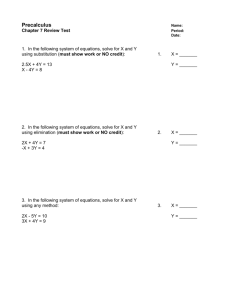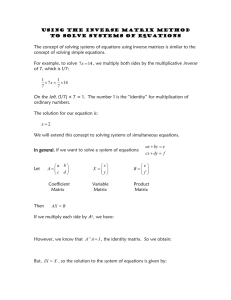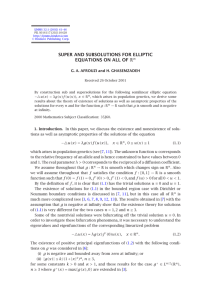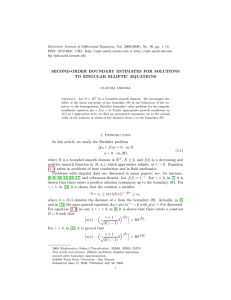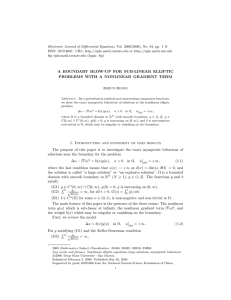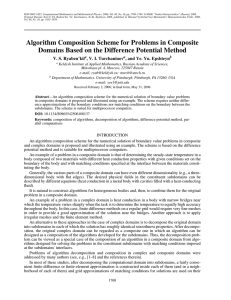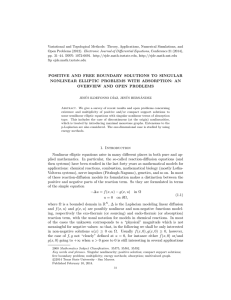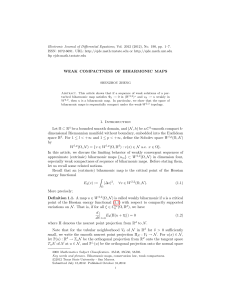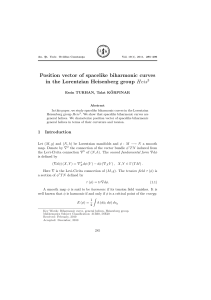AN INVERSE FOR BIHARMONIC PROBLEM
advertisement
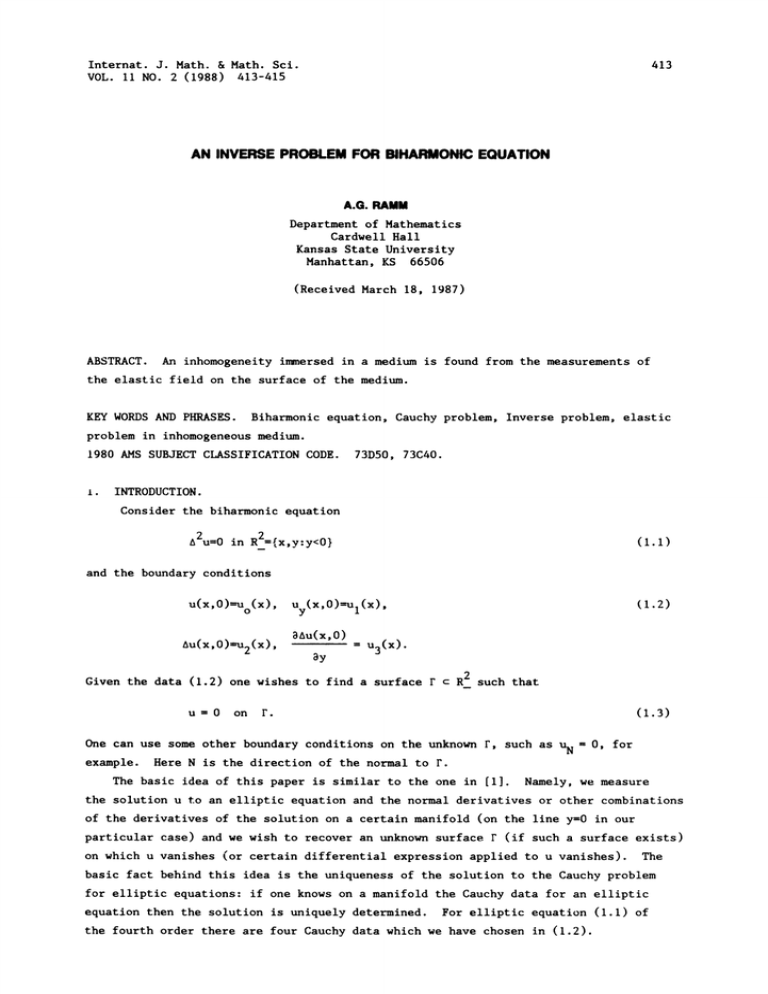
Internat. J. Math. & Math. Sci.
VOL. II NO. 2 (1988) 413-415
413
AN INVERSE PROBLEM FOR BIHARMONIC EQUATION
A.G. RAMM
Department of Mathematics
Cardwell Hall
Kansas State University
Manhattan, KS 66506
(Received March 18, 1987)
ABSTRACT.
An inhomogeneity immersed in a medium is found from the measurements of
the elastic field on the surface of the medium.
KEY WORDS AND PHRASES.
Biharmonic equation, Cauchy problem, Inverse problem, elastic
problem in inhomogeneous medium.
1980 AMS SUBJECT CLASSIFICATION CODE.
73D50, 73C40.
INTRODUCTION.
Consider the biharmonic equation
2u=0
in
R2:{x,y:y<0}
(i.l)
and the boundary conditions
u(x, 0)--Uo(X),
Au(x,0)--u2(x),
Given the data
Uy(X, 0)--Ul(X),
8nu(x,O)
8y
u3(x
(1.2) one wishes to find a surface F
u
0
on
c
R 2 such that
(1.3)
F.
One can use some other boundary conditions on the unknown F, such as u
N
example.
0, for
Here N is the direction of the normal to F.
The basic idea of this paper is similar to the one in [I].
Namely, we measure
the solution u to an elliptic equation and the normal derivatives or other combinations
of the derivatives of the solution on a certain manifold (on the line y=0 in our
particular case) and we wish to recover an unknown surface F (if such a surface exists)
on which u vanishes
(or
certain differential expression applied to u
vanishes).
The
basic fact behind this idea is the uniqueness of the solution to the Cauchy problem
for elliptic equations: if one knows on a manifold the Cauchy data for an elliptic
equation then the solution is uniquely determined.
For elliptic equation (i.I) of
the fourth order there are four Cauchy data which we have chosen in (1.2).
414
A.G. RAMM
The objective of this paper is to give a method for finding the unknown
r
on
(1.3) holds from the knowledge of the data (1.2). The method works
for other than (3) boundary conditions and for other than (I.I) elliptic equations.
which condition
Finally we wish to note that the problems of the type we discuss can be of interest
For example in the plane static problems of elasticity the deformation
in applications.
vector can be expressed in terms of the scalar solution
(this solution is called the deformation function).
r
face
of the inhomogeneity immersed in the elastic medium can be expressed in the form
similar to
find
of the biharmonlc equation
The boundary conditions on the sur-
r (for
(1.3): certain differential expressions involving X vanish on r. We wish to
example,the boundary of a crack) from the measurements of u on a certain
surface.
2.
A METHOD FOR SOLVING THE PROBLEM.
A. We wish to show that there is a solution to equation (i.i) which is of the form
u(x,y)
=[da{[Ao(a)
+
where/: =[_
satisfied.
+
[Bo(a)
+
XAl() + YA2()]
XBl(a)
+
YB2(a)]
Aj(a), Bj(e) are to be chosen
arbitrary Aj(a), Bj(a) decaying
and
For
exp(ix + y)
exp(iax
ay)}
(2.1)
so that the boundary conditions
(2. I) are
at infinity sufficiently fast, so that the
integral in (2.1) can be differentiated four times in x and y under the sign of the inte-
gral, the function (2.1) solves equation (i.i).
conditions
For the function (2.1)
to
satisfy
(1.2), the following equations should hold:
5o Ao(a) + Bo(a) + iA{ + iB{
I
A2(a) + B2(a) + Ao()
52
2ia(Al()
u
Here A’
3
dA/d=,
aBo(a)
+
i(Al)’
(2.3)
i(aBl)’
BI(=))+2a(A2(a) B2(a))
(2.4)
2AI(a) +2a2A2(a) 2ia2Bl(a)+22B2().
{ := (2)-lJf(x)exp(-i=x)dx and the Fourier transform
(2.5)
2i
sense of distributions.
(2.2)-(2.5).
+
(2.2)
We have 6 functions
A, B,
is taken in the
j =0,1,2, to satisfy four equations
Therefore two additional conditions can be imposed.
If, for example, we
choose these additional conditions in the form
A =0,
(2.6)
B 1 =0,
then (2.2) -(2.6) is a linear system of six equations for six unknown functions
j
0,i,2, which can be solved explicitly.
(2.2) -(2.5) can be
B
j,
Indeed, it follows from (2.6) that equations
written as
Uo
Ao +Bo;ul e(Ao- Bo) +A2 +B2"u2’ =2(A2 B2)
5
22(A2 + B2).
3
Aj,
(2.7)
INVERSE PROBLEM FOR BIHARMONIC EQUATION
415
This system has the unique solution:
A
[(2a)-lG2 + (2a2)-13]12,B2
2
[O + a -I~u I- (2a 2)
AO
[(2a2)-13_ (2a)-12]12,
-153 ]12 Bo=[Uo-a-I-. 1+(2a ) -.T ]/2
u
(2.8)
3
(2.1), (2.6) and (2.8) give an explicit analytical formal solution to problem
(I.I) (1.2). This solution is smooth in x and y in R provided that the data uj(x),
0 j 3, are such that the functions defined by formulas (2.8) decay sufficiently fast
as a +/-=, for example, faster than exp(-ala I) with any a > 0, so that the integral (2.1)
Formulas
converges and can be differentiated under the sign of integral.
B. Having solved problem (I.I) (1.2), we can find the unknown boundary r from
equation (1.3). Indeed, if the function u(x,y) is found, one can use the equation
u(x,y) =0
(2.9)
as an implicit equation of
r.
If y
y(x)
is an implicit function determined by equation
(2.9) then y=y(x) is an equation of a component of r.
This completes the description of the idea of the method for solving the inverse
problem formulated in section I.
The choices of the additional two conditions other than
(2.6) are possible.
REMARK I.
This problem is ill posed because the Cauchy problem for elliptic
Not for any data
j 0,1,2,3, formulas (2.8) define the
A
(2
i)
that
such
B
B
makes sense (see Example 2 below)
integral
O’ 2 o, 2
EXAMPLE 1. Let us take the data such that
1 if -la
and A (a)=0
o
-1
otherwise, A
=0. Then u(x,y)
B
daexp(iax+y)=2(ix+y)
2=
sinh(ix + y). Equation (2.9) for this u(x,y) is sinh(ix + y) 0. It has solution y-0,
uj(x),
equations is ill posed.
functions A
I=B I=A
x=n, n=0, +/-1,+/-2
EXAMPLE 2.
u2(x)--4, u3(x)=0.
delta-function.
A(a)l
2=B
Thus, there is no curve
Consider
ThUSo
Since
u(x,y)--x2+(y+)2-.
-6"(a),
u
6(a),
-1
the expression
6()
the data in this example cannot be used.
+(y+)2_
in the form
r
in
R 2 corresponding to the above data.
Clearly
2
A2u=0
46(a),
u
O
O3=0,
(x)=x 2
Ul(X)=l
where 6(a) is the
is not well defined, formula
(2.8) for
One can represent the function u(x,y)=x 2
(2.1) if one does not assume that
AI=BI=0.
REFERENCES
I.
2.
RAMM, A.G., 1986, A geometrical inverse problem, Inverse problems, 2, LIg-L21.
LANDAU, L. and LIFSHITZ, E., 1970, Theory of elasticity, Pergamon Press, New York.

